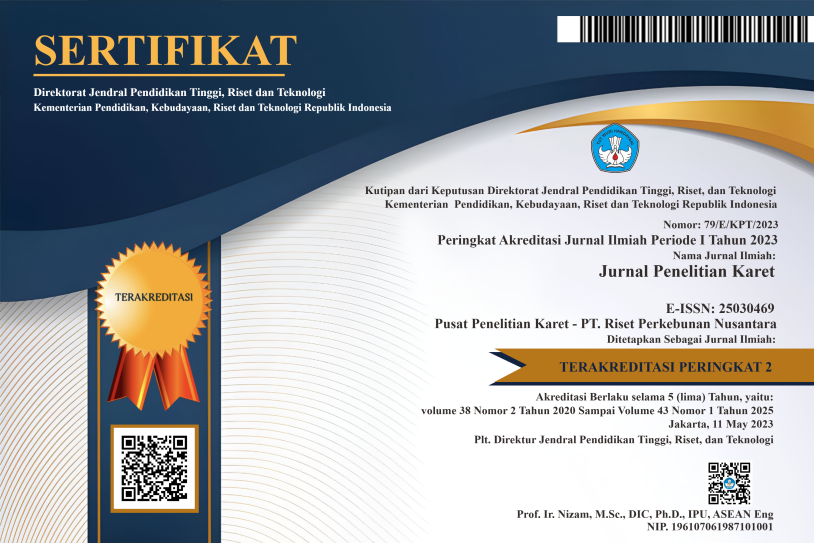PENGGUNAAN KOMPATIBILISER KARET ALAM EPOKSIDASI (ENR) PADA KOMPON TELAPAK BAN RAMAH LINGKUNGAN
DOI:
https://doi.org/10.22302/ppk.jpk.v42i1.890Keywords:
telapak ban, ban ECO, formulasi, silika, kompatibiliser, karet alam epoksiAbstract
Formulasi kompon telapak ban perlu dilakukan untuk mengoptimalkan kinerja ban ramah lingkungan (ban ECO). Formulasi telapak ban dilakukan pada karet non-polar berbahan pengisi silika dengan dan atau tanpa menggunakan kompatibiliser karet alam terepoksidasi (ENR). Penggunaan kompatibiliser ENR pada telapak ban ECO mampu meningkatkan dispersi bahan pengisi, yang ditandai dengan menurunnya nilai payne effect kompon B. Dispersi bahan pengisi yang baik lebih lanjut dapat meningkatkan interaksi fisik antar bahan pengisi dan bahan pengisi karet, karakteristik pematangan, kuat tarik, ketahanan kikis, dan cengkraman basah vulkanisat telapak ban ECO. Namun, sedikit menurukan interaksi kimia bahan pengisi-karet sehingga menurunkan apparent crosslink density kekerasan, young modulus, perpanjangan putus, dan ketahanan sobek dan meningkatkan ketahanan gelinding vulkanisat telapak ban ECO B. Maka formula kompon B perlu ditingkatkan untuk meningkatkan sifat mekanik vulkanisat dan efesiensi bahan bakar kendaraan.
References
Bokobza, L., Leroy, E., & Lalanne, V. (2009). Effect of filling mixtures of sepiolite and a surface modified fumed silica on the mechanical and swelling behavior of a styrene–butadiene rubber. European polymer journal, 45(4), 996-1001.
Cataldo, F. (2002). Preparation of silica- based rubber compounds without the use of a silane coupling agent through the use of epoxidized natural rubber. Macromolecular Materials and Engineering, 287(5), 348-352.
Choi, S. S. (2001). Improvement of properties of silica?filled styrene–butadiene rubber compounds using acrylonitrile–butadiene rubber. Journal of Applied Polymer Science, 79(6), 1127-1133.
Chonkaew, W., Minghvanish, W., Kungliean, U., Rochanawipart, N., & Brostow, W. (2011). Vulcanization characteristics and dynamic mechanical behavior of natural rubber reinforced with silane modified silica. Journal of nanoscience and nanotechnology, 11(3), 2018-2024.
Clement, F., Bokobza, L., & Monnerie, L. (2005). Investigation of the Payne effect and its temperature dependence on silica-filled polydimethylsiloxane networks. Part I: Experimental results. Rubber Chemistry and Technology, 78(2), 211-231.
Das, A., Debnath, S. C., De, D., & Basu, D. K. (2004). Evaluation of physical properties and curing characteristics of silica?filled ethylene–propylene–diene terpolymer in the presence of chloroprene rubber. Journal of Applied Polymer Science, 93(1), 196-200.
Dierkes, W. K., Sengloyluan, K., Kaewsakul, W., Noordermeer, J. W., Sahakaro, K., & Blume, A. (2019). New Approaches to Increase the Compatibility of Natural Rubber and Silica for Reduction of Rolling Resistance of Truck and Bus Tires. Paper presented at the ITEC in Focus: Green Tire 2019.
Fathurrohman, M. I., Rugmai, S., Hayeemasae, N., & Sahakaro, K. (2020). Better balance of silica-reinforced natural rubber tire tread compound properties by the use of montmorillonite with optimum surface modifier content. Rubber Chemistry and Technology, 93(3), 548-566.
Goswami, M., Ghosh, M. M., Dalmiya, M. S., Sharma, S., Ghorai, S. K., & Chattopadhyay, S. (2020). A finite element method based comparative fracture assessment of carbon black and silica filled elastomers: reinforcing efficacy of carbonaceous fillers in flexible composites. Polymer testing, 91, 106856.
Grunert, F. (2018). Analytical method development to predict the in-rubber dispersibility of silica: University of Twente Enschede, The Netherlands.
Hayichelaeh, C., Reuvekamp, L., Dierkes, W., Blume, A., Noordermeer, J., & Sahakaro, K. (2018). Enhancing the silanization reaction of the silica-silane system by different amines in model and practical silica-filled natural rubber compounds. Polymers, 10(6), 584.
Kaewsakul, W., Sahakaro, K., Dierkes, W. K., & Noordermeer, J. W. (2014). Cooperative effects of epoxide functional groups on natural rubber and silane coupling agents on reinforcing efficiency of silica. Rubber Chemistry and Technology, 87(2), 291-310.
Li, W., Peng, W., Ren, S., & He, A. (2019). Synthesis and characterization of trans-1, 4-poly (butadiene-co-isoprene) rubbers (TBIR) with different fraction and chain sequence distribution and its influence on the properties of natural rubber/TBIR/carbon black composites. Industrial & Engineering Chemistry Research, 58(24), 10609-10617.
Li, Y., Han, B., Liu, L., Zhang, F., Zhang, L., Wen, S., . . . Shen, J. (2013). Surface modification of silica by two-step method and properties of solution styrene butadiene rubber (SSBR) nanocomposites filled with modified silica. Composites Science and Technology, 88, 69-75.
Mandal, N., Datta, S., Manjaiah, K., Dwivedi, B., Kumar, R., & Aggarwal, P. (2018). Zincated nanoclay polymer composites (ZNCPCs): Synthesis, characterization, biodegradation and controlled release behaviour in soil. Polymer-Plastics Technology and Engineering, 57(17), 1760-1770.
Murali Manohar, D., Chakraborty, B. C., & Shamshath Begum, S. (2021). Hardness–Elastic Modulus Relationship for Nitrile Rubber and Nitrile Rubber–Polyvinyl Chloride Blends. Paper presented at the Advances in Design and Thermal Systems: Select Proceedings of ETDMMT 2020.
Nakason, C., Kaesaman, A., Wongkul, T., & Kiatkamjornwong, S. (2001). Rheological and curing properties of reactive blending products of epoxidised natural rubber and cassava starch. Plastics, rubber and composites, 30(4), 154-161.
Noordermeer, J. W. (1998). Recent developments in rubber processing, leading to new applications such as the “green tyre”. Paper presented at the Macromolecular symposia.
Poh, B., & Tan, B. (1991). Mooney scorch time of epoxidized natural rubber. Journal of Applied Polymer Science, 42(5), 1407-1416.
Ryu, G., Kim, D., Song, S., Hwang, K., Ahn, B., & Kim, W. (2021). Effect of epoxide content on the vulcanizate structure of silica-filled epoxidized natural rubber (Enr) compounds. Polymers, 13(11), 1862.
Sahakaro, K. (2017). Mechanism of reinforcement using nanofillers in rubber nanocomposites. In S. Thomas & H. J. Maria (Eds.), Progress in Rubber Nanocomposites (pp. 81-113): Woodhead Publishing.
Sarkawi, S., Dierkes, W. K., & Noordermeer, J. W. (2014). Elucidation of filler-to-filler and filler-to-rubber interactions in silica-reinforced natural rubber by TEM Network Visualization. European polymer journal, 54, 118-127.
Sarkawi, S. S., Dierkes, W. K., & Noordermeer, J. W. (2015). Morphology of silica-reinforced natural rubber: The effect of silane coupling agent. Rubber Chemistry and Technology, 88(3), 359-372.
Sattayanurak, S., Sahakaro, K., Kaewsakul, W., Dierkes, W. K., Reuvekamp, L. A., Blume, A., & Noordermeer, J. W. (2020). Synergistic effect by high specific surface area carbon black as secondary filler in silica reinforced natural rubber tire tread compounds. Polymer testing, 81, 106173.
Sedov, I., Magsumov, T., Abdullin, A., Yarko, E., Mukhametzyanov, T., Klimovitsky, A., & Schick, C. (2018). Influence of the cross-link density on the rate of crystallization of poly (?-Caprolactone). Polymers, 10(8), 902.
Sengloyluan, K., Sahakaro, K., Dierkes, W. K., & Noordermeer, J. W. (2012). Use of epoxidized natural rubber as a compatibilizer in silica-filled natural rubber compounds. Paper presented at the 28th International Conference of the Polymer Processing Society.
Sengloyluan, K., Sahakaro, K., Dierkes, W. K., & Noordermeer, J. W. (2014). Silica-reinforced tire tread compounds compatibilized by using epoxidized natural rubber. European polymer journal, 51, 69-79.
Wang, M.-J. (1999). The role of filler networking in dynamic properties of filled rubber. Rubber chemistry and technology, 72(2), 430-448.
Wang, Y., Liao, L., Zhong, J., He, D., Xu, K., Yang, C., . . . Peng, Z. (2016). The behavior of natural rubber–epoxidized natural rubber–silica composites based on wet masterbatch technique. Journal of Applied Polymer Science, 133(26).
Wieczorek, M., & Jackowski, J. (2018). Car tyres with reduced energy consumption. Journal of KONES, 25(1), 447-456.
Wolff, S., Wang, M.-J., & Tan, E.-H. (1993). Filler-elastomer interactions. Part VII. Study on bound rubber. Rubber Chemistry and Technology, 66(2), 163-177.
Xu, T., Jia, Z., Luo, Y., Jia, D., & Peng, Z. (2015). Interfacial interaction between the epoxidized natural rubber and silica in natural rubber/silica composites. Applied Surface Science, 328, 306-313.
Downloads
Published
How to Cite
Issue
Section
License
Copyright (c) 2024 Norma Arisanti Kinasih, Muhammad Irfan Fathurrohman, Santi Puspitasari, Dewi Kusuma Arti

This work is licensed under a Creative Commons Attribution-ShareAlike 4.0 International License.
Submission of a original research article in Jurnal Penelitian Karet implies that the submitted  manuscript has not been published in any scientific journal (except being part of the abstract, thesis, or report). The submitted manuscript also is not under consideration for publication elsewhere. All co-authors involve in the publication of the manuscript should give their approval.
Once, the manuscript is accepted and then published in Jurnal penelitian Karet, the Author(s) keep hold the copyright and retain publishing right without restrictions.
Author(s) and Jurnal Penelitian Karet users are allowed to multiply the published manuscript. The journal users are also permissible to share the published manuscript with an acknowledgement to the Author(s). The Editorial Boards suggest that the Authors should manage patent before publishing their new inventions.
















